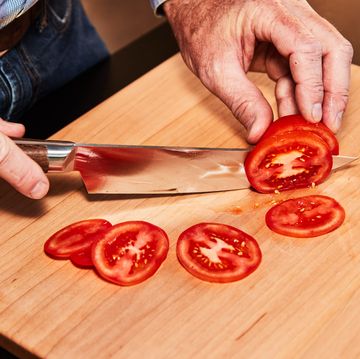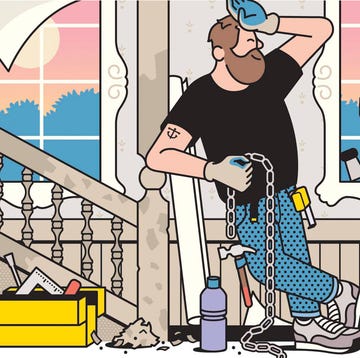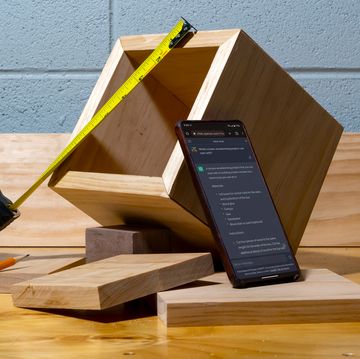POP Projects is a collection of new and classic projects from more than a century of Popular Mechanics. Master skills, get tool recommendations, and, most importantly, build something of your very own.
Update: When we commissioned this shed project 20 years ago, we had no idea we were creating a hero of a DIY project. Super Shed indeed. Hundreds of thousands of visits later, Neal tells us his shed is still standing proudly in the Adirondacks, despite an utter lack of maintenance!
A few things have changed in the lumber business since this shed was built. To have a look at the original project as it appeared in print, go here. (Illustration by Eugene Thompson)
In the interest of transparency here in 2020, close inspection reveals a couple of mistakes in these plans regarding the shed’s windows (hey, it happens). 1) The introduction says the windows are 24 x 32 inches but the technical art shows a 28 x 32 inch window, and 2) the rough opening for either size window is listed as 30-1/8 x 33¼. That won’t work well for either size window. For our new materials list, we found a window at 29 x 32. The rough opening for that window would be 31-1/2 x 34. Shim the window in place and call it a day, and if you hinge a barn sash to the exterior trim, size the rough opening so the window can swing into the opening, and place window stops inside the jamb.
Next, the chemical treatment used in the pressure treated floor and rim joists has changed. When this shed was built, it was chromated copper arsenate (CCA); now it is alkaline copper quarternary, an effective preservative but one that is extremely corrosive to fasteners. You must use hot-dipped galvanized joist brackets and the same for the joist bracket nails. Use stainless steel screws or coated deck screws to attach the shed’s plywood floor to this framing.
Finally, study the illustrations carefully, and read the step-by-step instructions. Note that the shed’s wall framing is offset slightly from the floor framing (base) such that the outside of the wall sheathing is flush with the rim joists. This enables the cedar siding to smoothly cover the base and walls. Another detail that might trip up a first-time builder are the gussets on the trusses. When you stand the trusses up, be sure the gussets on the end trusses are facing the inside of the shed. Small dimensional discrepancies are bound to occur during construction, and even a fraction of an inch can affect the angle and fit of these trusses. — Roy Berendsohn, test editor
The design of your garden shed can take any form, from a simple lean-to to a large free-standing building. Ours occupies a modest 6 x 8-ft. area—enough for a variety of tools, but not so large that it dominates a backyard landscape. The straightforward design is easy to expand—up to about 8 x 12 ft.—to suit your storage needs. Before you begin work, contact your local building codes office and find out about necessary permits or other requirements for this type of building.
Our shed uses standard framing techniques and materials. It's sheathed with 1/2-in. C/D plywood and sided with 1 x 6 tongue-and-groove cedar boards. The exterior trim is rough-sawn cedar.
In most cases, a shed of this size will not require an elaborate foundation—it's fine to simply rest the structure on four corner blocks that sit on the ground. Some excavation is inevitable to provide a level and firm base, but there's really no need to dig below the frost line. If the building settles unevenly, simply jack up a low corner and place cedar shims between the corner block and floor framing. We used 7-1/2 x 12 x 16-in. solid concrete blocks at the corners.
To bring light into our shed, we installed 24 x 32-in. barn-sash windows. If you can't find these stocked by a local supplier, something similar can usually be ordered.
Plans and Materials
Step 1: Site Work
Begin by marking out the building's location in your yard. For a structure of this size, it's simplest to build a lightweight frame that's the exact size of the shed, then use the frame to mark the site.
Use 3/4-in.-thick pine to build your frame. Cut the sides to the exact dimensions of the floor, and use one screw in each corner to fasten the sides into a rectangle. Screw a diagonal brace between two sides of the frame to hold it square.
Clear the building site and level any obvious high spots. Place the frame in the site and adjust its position until you're happy with the location of the shed. Drive stakes into the ground to mark each corner, stretch string between them (Photo 1) and then remove the frame.
Step 2: Site Work
Find the highest corner of the site and excavate for the first foundation corner block. Plan on having 3 to 4 in. of block exposed above grade. Dig out an area several inches wider than the block. Spread 2 or 3 in. of crushed stone in the hole to form a stable base for the block.
Now you're ready to position the first block, aligning its edges with the layout string. Check that the block is level across its length and width, and adjust the crushed stone as required.
Step 3: Site Work
Use a long, straight 2 x 4 and level to check the relative height of the second corner, then excavate the site for the block. Check that the second block is level with the first, and add the remaining corner blocks in the same way.
Step 4: Building The Floor
It's a good idea to use pressure-treated lumber for the floor joists. Cut 2 x 6 stock to length for the front and back rim joists, and then lay out the locations of the floor joists on 16-in. centers. Nail joist hangers to the inside surface of each inner joist using 1-1/2-in. joist hanger nails.
Step 5: Building The Floor
Next, place the inner front and back joists between the corner blocks, and then cut and position the floor joists (Photo 5). Nail the floor joists in place, then attach the outer rim joists to the front and back of the floor frame.
Step 6: Building The Floor
Compare opposite diagonal measurements of the floor assembly to check that it's square. Nail 3/4-in.-thick plywood to the joists for the shed floor.
After doubling the front and rear joists, add the 3/4-in. plywood floor. Nail it in place with 8d nails spaced about 6 in. apart.
Step 7: Wall Construction
Cut 2 x 6 stock to size for the door and window headers. Use pieces of 1/2-in. plywood as spacers between the 2 x 6s to bring the header assemblies to 3-1/2 in. thick. Nail together the header pieces with 16d common nails.
Cut 2 x 4 stock to length for the wall studs and window and door jack studs. Nail each jack stud to a wall stud with 8d common nails. Build the four corner posts by nailing three 2 x 4 spacers between two studs.
Begin framing the back wall by laying out the stud locations on the top and bottom plates. Then, lay out the framing members on the deck. Nail through the top plate and into the wall members with two 16d common nails at each stud. Secure the bottom plate to the wall studs in the same fashion. Frame the window opening, and nail the second top plate to the wall, keeping its ends back 3-1/2 in. from each end of the wall.
Step 8: Wall Construction
Now compare the opposite diagonal measurements of the wall and adjust the assembly until it's square. Then, apply 1/2-in. plywood sheathing, using 6d common nails spaced about 6 in. apart.
Stand the rear wall, bracing it with 2 x 4s nailed between the wall and the outside floor joists (Photo 8). Nail the bottom plate to the deck so the plywood sheathing is flush with the edge of the deck.
Step 9: Wall Construction
Frame the front wall, but don't apply the sheathing yet. Instead, stand the framed wall and brace it. Position the wall 1/2 in. from the deck edges to allow for the thickness of the sheathing. Then frame the side walls, one at a time, and stand them. Leave the second top plate off the side walls until they are raised. Nail the walls together at the corners, and then cut and install the side wall top plates (Photo 9). Use a level to check that the corners of the building are plumb, and nail temporary diagonal braces to the inside surface of each wall.
Frame and raise the remaining walls without sheathing. After nailing together the corner studs, add the top plates.
Step 10: Wall Construction
Apply the remaining plywood sheathing (Photo 10). At the side walls, keep the plywood 1-1/2 in. down from the top to provide room to nail the gable-end sheathing.
Step 11: Framing The Roof
Use a framing square to lay out the 5-in. pitch on the first roof rafter (Photo 11). Cut out the rafter and use it as a pattern to make the second rafter. Test the first two for proper fit, then trace and cut the remaining rafters.
To find the rafter cutting angle, align the 5- and 12-in. marks on the framing square's legs with the edge of the rafter stock.
Step 12: Framing The Roof
Cut a gusset for each truss from 1/2-in.-thick plywood as shown in the plans. Use a sheet of 3/4-in. plywood as an assembly table, and draw the outline of the roof truss directly on the plywood surface. Align two rafters over the pattern and nail the gusset to the rafters with 1-1/2-in. roofing nails (Photo 12).
Step 13: Framing The Roof
Toenail the trusses to the front and rear walls with 8d common nails (Photo 13). At the gable ends keep the gussets on the inside faces of the trusses.
Cut 2 x 6 stock to length for the subfascia, and nail the boards to the rafter ends with 16d common nails. Cut and install the gable-end sheathing, and then nail 1 x 6 pine furring over the gable rafters.
Rip cedar stock to width for the front and back soffits and cut it to length. Use 6d galvanized finishing nails to fasten the soffit boards to the rafters and subfascia. Then, install the cedar fascia and rake trim.
Install the plywood roof deck, allowing it to overhang the fascia by 1/2 in. along the eaves. Nail aluminum drip edge to the eaves, and apply roofing felt. Then, install the drip edge along the rake edges.
Step 14: Roofing And Siding
Follow the manufacturer's directions for installing the roof shingles.
Use 1/2-in. plywood for the roof deck and cover it with roofing felt. Install shingles following the manufacturer's instructions.
Step 15: Roofing And Siding
Since the tongue-and-groove siding is installed vertically, add 2 x 4 nailing blocks between the studs, about halfway up the wall. Cut and install these nailers by toenailing them between adjacent studs.
If you plan to stain or paint the trim a different color than the shed siding, it's a good idea to finish the roof trim before applying the siding. Cut siding boards to length and begin installing them at a corner of the building. Use galvanized finishing nails to fasten the boards—8d nails for fastening to the 2 x 4 framing and 6d nails for the plywood sheathing (Photo 15). Face nail the first board, but fasten succeeding boards with nails driven diagonally through the tongue so the heads will be hidden. Set the nailheads slightly below the wood surface.
Step 16: Windows And Doors
After staining or painting the siding, install the door and window jambs (Photo 16). Nail the jambs directly to the framing, with the outside edge of each jamb flush to the face of the siding. At the windows, slope the sill pieces about 5° toward the outside of the building, add the top jambs, and then cut the side jambs to fit.
Cut stops for the windows from 1 x cedar stock, and install the outer stops with 6d galvanized finishing nails. Then, place a window in each opening and add the inner stops.
Rip door and window trim and shed corner boards from rough-sawn cedar. Cut each piece to length and nail in place.
Step 17: Windows And Doors
Cut siding boards to length for the shed door. Use clamps to pull the boards together, but don't use glue on the joints. Cut the battens for the door, and screw them to the inside surface of the boards.
Hold the door hinges in place and mark the mounting-hole locations. Bore pilot holes and fasten the hinges to the shed. Position the door with a 1/4-in. space on the sides and top, and mark the hinge holes. Bore pilot holes and mount the hinges (Photo 17). Install the door pull and hasp. Cut the doorstops and nail them in place on the top and open-side jamb. Then, stain or paint the windows, door and remaining trim.
We built a ramp from pressure-treated stock to make it easier to wheel a mower or snowthrower into the shed. To build a ramp, use 2 x 6 material spaced about 1/2 in. apart for the ramp deck, and 2 x 4 stock for battens underneath.


















